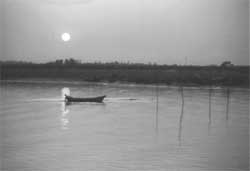Drained dry...
 february 1, 1997, was celebrated world-wide as the World Wetlands Day. The World Wide Fund for Nature even issued a statement asking governments to reaffirm their commitment to conservation and restoration of wetlands throughtout the world. However, for the numerous waterbodies, fringed frequently by marshy wetlands, and scattered amidst the villages, tea gardens and forests of Assam, their seems to be no respite as continuing degradation takes its toll. Locally known as beels , these wetlands extending over anything from a few sq km to nearly a hundred, are home not only to numerous water fowls, both resident and migratory, but are also the breeding grounds for several species of fish, including the bigger riverine varieties. Unfortunately, Assam's wetlands are often overlooked, perhaps due to other attractions like the one-horned rhinos inhabiting its national parks, or because of their abundance. It is only now that scientists from the Assam Remote Sensing Application Centre have undertaken a satellite survey to identify and map the wetlands.
february 1, 1997, was celebrated world-wide as the World Wetlands Day. The World Wide Fund for Nature even issued a statement asking governments to reaffirm their commitment to conservation and restoration of wetlands throughtout the world. However, for the numerous waterbodies, fringed frequently by marshy wetlands, and scattered amidst the villages, tea gardens and forests of Assam, their seems to be no respite as continuing degradation takes its toll. Locally known as beels , these wetlands extending over anything from a few sq km to nearly a hundred, are home not only to numerous water fowls, both resident and migratory, but are also the breeding grounds for several species of fish, including the bigger riverine varieties. Unfortunately, Assam's wetlands are often overlooked, perhaps due to other attractions like the one-horned rhinos inhabiting its national parks, or because of their abundance. It is only now that scientists from the Assam Remote Sensing Application Centre have undertaken a satellite survey to identify and map the wetlands.
Not many are aware that many of these unique waterbodies and the aquatic resources they harbour are gravely endangered and some are on the verge of extinction. To understand the implications, it is necessary to understand the diverse ecology of the beels and the intimate link they have with the biology and breeding behaviour of fish, including the riverine species.
For years, the piscifauna of Assam have regularly spawned, hatched and grown in the beels before returning to the rivers. As a result, fish, both riverine and lentic, were abundant in Assam. In recent years, however, there has been a decline in the population and diversity of the fishes in the beels . Several factors have contributed to this, but the primary reason is the drastic change in the ecology of the beels .
Creating barriers Degradation of the beels reflect the government's piecemeal approach to problem-solving and exemplify the disasters created by the lack of foresight and integrated planning. The degradation of the beels and the threat to the aquatic creatures started with government measures for flood control several years ago. All along the Brahmaputra and her tributaries, sluice gates were constructed to prevent floodwaters from entering the natural canals and waterways and inundating agricultural fields and village settlements. These sluice gates also regulate the volume of water entering the beels . With restricted access to breeding and spawning grounds, riverine species are thus deprived of high quality spawning and feeding habitats.
They thus have to settle for other spawning areas, however unsuitable. This takes a heavy toll on the frys and fingerlings, as mortality increases due to improper shelter and
Related Content
- Status report by the Chandigarh Pollution Control Committee on N-Choe, 16/01/2024
- Order of the National Green Tribunal regarding pollution of Lassara drain, Ludhiana, Punjab, 08/12/2023
- Order of the National Green Tribunal regarding violation of environmental norms by ACC Cement, village Salai Banwa, district Sonbhadra, Uttar Pradesh, 17/05/2023
- Response by Uttar Pradesh regarding discharge of untreated sewage in Pamari drain in Firozabad district which is adding to pollution of river Yamuna, 01/05/2023
- Report by the Tambaram City Municipal Corporation, Chennai, Tamil Nadu to the NGT on the disposal of sewage/sullage water in the storm water drain which leads to Thangal Eri lake, 25/04/2022
- Order of the National Green Tribunal regarding drain encroachment and diversion of drain, village Kauluva, Bhopal, Madhya Pradesh, 10/08/2021
